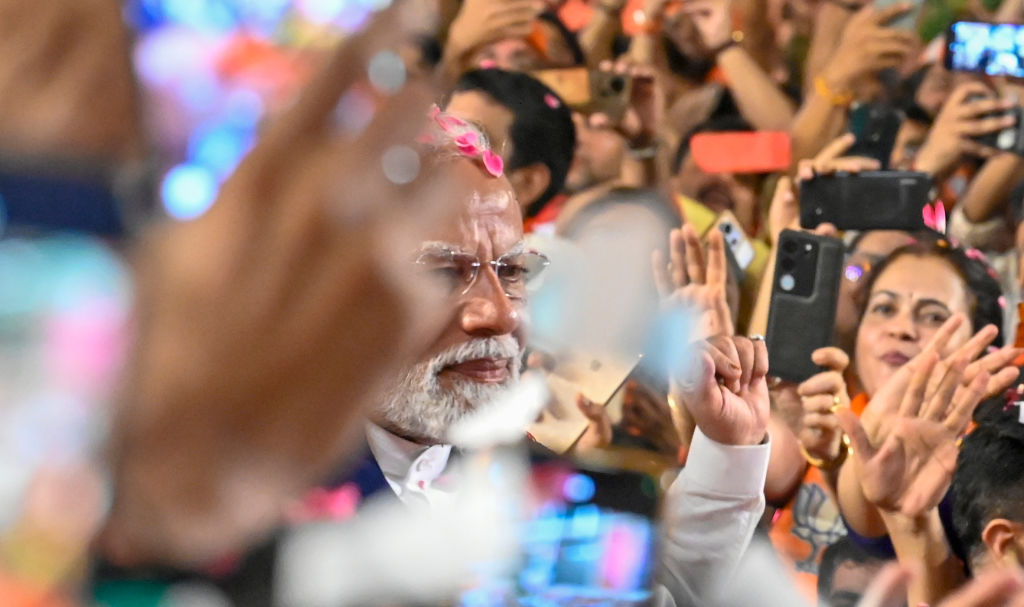India’s 2024 parliamentary election have reaffirmed the strength and vibrancy of the country’s democratic process, showcasing the electorate’s power to shape their government. The ruling National Democratic Alliance (NDA), led by the Bharatiya Janata Party (BJP), secured an electoral victory. While the BJP did not secure a full majority – it won 240 of 543 seats – Prime Minister Narendra Modi is back in office for a third term, leading a coalition government.
Despite a brutal summer with temperatures hovering between 45–50°C, millions of Indians participated in the elections. While the voter turnout was around 65.8%, marginally lower than the 67.4% turnout in the 2019 election, the absolute number of voters surged from approximately 614 million in 2019 to over 642 million in 2024. The Election Commission of India (ECI) noted that voter turnout was approximately “1.5 times the voters of all G7 countries and 2.5 times the voters in the EU27.”
Elections in a few districts is akin to national elections in many other parts of the world.
A notable feature of recent elections has been the active participation of women voters. An estimated 312 million women voted this year, seeing the elector gender ratio increase. Political parties have targeted this demographic with populist schemes such as the promise of cash handouts. However, the efficacy of such cash handouts and other freebies remains contentious, with concerns that they may create short-term benefits, strain public finances, and fail to empower women in the long run. While there is a debate on the policy preferences of women voters, the fact remains that women voters have emerged as a vital voting bloc. Approximately 1.4 million women also serve as elected members of local governments in rural areas, indicating a growing presence in the polity.
Elections in India are conducted according to the First-Past-The-Post (FPTP) electoral system, without a run-off. This makes gaining more than 50% of the vote share challenging for any political party. In other countries with the FPTP system, such as the United Kingdom and Canada, politics revolves around two or three major political parties. On the other hand, in India, as a recent Reuters report pointed out, approximately 744 political parties contested the elections, and of these, over 30 of these parties had won at least one seat in the 2019 elections. Moreover, the average number of candidates per constituency, which was around 4.67 in 1951, increased to 15 in 2019. Given the growing density of contestants, the BJP receiving about 236 million votes (235,973,935) accounting for just over a third of the total votes, is a noteworthy performance.

The 2024 experience has a few important takeaways for the elections in the coming years. Due to a lack of awareness about rigorous procedures and the logistics required to participate in elections, a few candidates’ incomplete nomination papers were rejected, and some well-intentioned professionals lost elections. There is an urgent need to educate people on these aspects, specifically at the high school and undergraduate levels, to engender more enlightened conversations on the election procedure within and outside the country.
Stopping money from corrupting the vote was critical in the ECI’s efforts to ensure a clean election. However, there is a need to recognise that political parties need significant financial resources to conduct legitimate activities. The average district in India, with approximately 1.86 million people, is significantly bigger than many countries in the world. So, a collection of Zilla Parishad (local government) elections in a few districts is akin to national elections in many other parts of the world. Parties and individuals contesting require substantial financial resources.
The funding for political parties should be based on rational criteria. A European political party with “at least one Member of the European Parliament” receives funding from the European authority. However, in the Indian context, election funding based on the performance in the previous elections will privilege the established political parties. Given the extraordinary logistical requirements, state funding of political parties poses significant fiscal challenges, potentially diverting resources from essential social programs. Moreover, there’s a risk of misuse of state funding, with parties getting constituted merely to obtain subsidies. Such funding might not entirely eliminate undisclosed private funding, perpetuating transparency issues. Therefore, political reform should encourage transparent private funding that also supports new political players.
During the recent election, the selection of candidates by the political parties became an important node of conversation. There is an urgent need to foster greater internal democracy within the political parties. The ECI is already burdened with conducting numerous elections and does not have the wherewithal to conduct internal elections of over 700 political parties. Creating impartial institutions and modalities to improve internal elections within the parties (with millions as members) mandates closer attention.
India has pulled off the world’s largest democratic electoral exercise with aplomb. In the coming years, further deepening of democracy can be achieved through improved political recruitment, which requires an appreciation of the logistics required to participate in elections, relatively easy access to legitimate political funding, and a more robust inner-party democracy.

